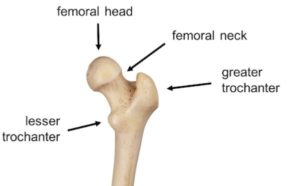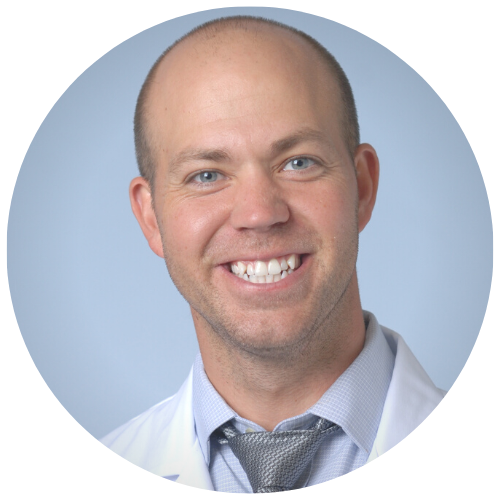The pain is constant and getting worse. You are getting worried that you may have a serious hip problem or arthritis. What muscles are on the side of your hip? What are the causes of outer hip pain? What can I do for outer hip pain? Are there regenerative options? Let’s dig in.
Understanding Hip Basics
The hip is a ball-socket joint. The ball is the top part of the thigh bone (femur). The socket is formed by the ilium bone which is one of three bones that make up the pelvis. The ball-socket joint moves in different directions and is lined with cartilage. The actual hip joint is located approximately at the crease between your stomach and the top of your thigh. This area is also known as the groin. The top of the ilium bone is called the iliac crest (waist bone). If you firmly place your hand on your waist you can feel a bone that spans your side. This is your iliac crest. This is illustrated in the image to the right.
The femur bone spans from the ball portion of the hip down to the knee. On the side of the femur is a boney

the knob that is called the greater trochanter. This is important as this is where many muscles attach. If you are standing and put the arms to your sides you can feel a boney knob on the side of your thigh. This is your greater trochanter.
What Muscles Are on the Side of Your Hip?
Tendons are thick pieces of connective tissue that enable a muscle to attach to the bone. There are many important muscles that attach to the top of the waist bone. These include:
Tensor Fasciae Latae: A thin yet powerful muscle that stabilizes the hip, extends the hip and along with the gluteus maximus forms the iliotibial band. (1)
Internal and External Obliques: Important abdominal muscles that assist with respiration and produce trunk rotation and side-bending.
Latissimus Dorsi: A large, triangular muscle in the back that is important in the flexion, extension of the trunk, and various shoulder movements (2).
Related: Gluteal Tendinopathy
Are There Other Muscles On the Side of Your Hip?
Yes. Immediately below the top of the waist bone are the powerful and important gluteal muscles. The most important muscles are the Gluteus maximus, medius, and minimus. They travel down the hip bone and attach to greater trochanter. These muscles attach via tendons which are thick bands of connective tissue. The tendons are susceptible to degeneration, injury, inflammation, and tears. As such these tendons are possible sources of the side of hip pain.
What Are the Causes of Outer Hip Pain?
There are many different causes of outer hip pain. I have categorized them into two groups: Direct and Referred. Direct causes are those directly related to the hip bone itself and the structures that attach to it. Referred pain is pain that is felt or perceived in a part of the body other than its actual source.
Direct Causes of Outer Hip Pain Include:
- Hip Fracture (4)
- Cancer
- Tendonitis: Inflammation, degeneration, or tearing of any of the muscles or tendons that attach to the ilium.
- Bursitis: A bursa is a fluid-filled sac that enables muscles, tendons, and ligaments to glide smoothly over boney surfaces. The bursae can become inflamed and cause outer hip pain. This is oftentimes referred to as trochanteric bursitis by your doctor.
- Ligament injury: Many ligaments attach to the hip and provide important support. The iliolumbar ligament for example attaches to the iliac crest and is critical to the stability of the sacroiliac joint (3). These ligaments can be injured, stretched, or torn.
- Pregnancy and childbirth (5)
Referred Sources of Outer Hip Pain Include:
- Sacroiliac joint injury
- Lumbar disc injury: disc protrusions, herniations, and bulges can cause outer hip pain (6)
What Can I Do for Outer Hip Pain?
For the best results, one needs to identify and treat the underlying problem or source of the pain. Physical examination is critical and oftentimes can help identify the underlying problem or problems. An X-ray can identify fractures or cancer lesions in the bone. In-office ultrasound is useful to evaluate these structures and avoids a trip to the MRI center and possible viral exposure. The Physicians at the Centeno-Schultz Clinic are experts in the treatment of outer hip pain and the diagnosis of muscle, tendon, and ligament injuries. Treatment options include PRP and stem cells which can accelerate healing (7). To learn more about outer hip pain please click on the video below.
In Conclusion
The hip is a ball-socket joint. The ball is on the top part of the thigh bone which is called the femur. The socket is formed by the ilium bone. The hip joint is actually located in the groin area. Many of us have pain in the outer hip. Muscles and tendons attach to both the iliac crest and the greater trochanter. These muscles include tensor fascia lata, internal and external obliques, gluteus maximus, minimus, and medius. These muscles and tendons can become injured, degenerated or torn, and become the source of outer hip pain. There are two major causes of outer hip pain which include direct and referred. The best treatment for outer hip pain requires the identification and treatment of the underlying problem or source of pain. Often times the outer hip pain does not involve the hip joint itself.
If you spend more time on the foam roller than you do working out we have treatment options to help you. The Physicians at the Centeno-Schultz Clinic are experts in the diagnosis and management of outer hip pain. Schedule a Telemedicine consultation from the comfort of your home or cabin. Talk with a board-certified, fellowship-trained physician about regenerative treatment options which may include PRP or stem cells. Don’t let this pain hijack your life and your joy. Schedule now and get back in the game.
Book an Appointment with a Doctor to Treat Your Outer Hip Pain

Christopher J. Centeno, MD
Christopher J. Centeno, M.D. is an international expert and specialist in Interventional Orthopedics and the clinical use of bone marrow concentrate in orthopedics. He is board-certified in physical medicine and rehabilitation with a subspecialty of pain medicine through The American Board of Physical Medicine and Rehabilitation. Dr. Centeno is one of the few physicians in the world with extensive experience in the culture expansion of and clinical use of adult bone marrow concentrate to treat orthopedic injuries. His clinic incorporates a variety of revolutionary pain management techniques to bring its broad patient base relief and results. Dr. Centeno treats patients from all over the US who…
Read more
John Schultz, MD
John R. Schultz M.D. is a national expert and specialist in Interventional Orthopedics and the clinical use of bone marrow concentrate for orthopedic injuries. He is board certified in Anesthesiology and Pain Medicine and underwent fellowship training in both. Dr. Schultz has extensive experience with same day as well as culture expanded bone marrow concentrate and sees patients at the CSC Broomfield, Colorado Clinic, as well the Regenexx Clinic in Grand Cayman. Dr. Schultz emphasis is on the evaluation and treatment of thoracic and cervical disc, facet, nerve, and ligament injuries including the non-surgical treatment of Craniocervical instability (CCI). Dr. Schultz trained at George Washington School of…
Read more
John Pitts, M.D.
Dr. Pitts is originally from Chicago, IL but is a medical graduate of Vanderbilt School of Medicine in Nashville, TN. After Vanderbilt, he completed a residency in Physical Medicine and Rehabilitation (PM&R) at Emory University in Atlanta, GA. The focus of PM&R is the restoration of function and quality of life. In residency, he gained much experience in musculoskeletal medicine, rehabilitation, spine, and sports medicine along with some regenerative medicine. He also gained significant experience in fluoroscopically guided spinal procedures and peripheral injections. However, Dr. Pitts wanted to broaden his skills and treatment options beyond the current typical standards of care.
Read more
Jason Markle, D.O.
Post-residency, Dr. Markle was selected to the Interventional Orthopedic Fellowship program at the Centeno-Schultz Clinic. During his fellowship, he gained significant experience in the new field of Interventional Orthopedics and regenerative medicine, honing his skills in advanced injection techniques into the spine and joints treating patients with autologous, bone marrow concentrate and platelet solutions. Dr. Markle then accepted a full-time attending physician position at the Centeno-Schultz Clinic, where he both treats patients and trains Interventional Orthopedics fellows. Dr. Markle is an active member of the Interventional Orthopedic Foundation and serves as a course instructor, where he trains physicians from around the world.
Read more
Brandon T. Money, D.O., M.S.
Dr. Money is an Indiana native who now proudly calls Colorado home. He attended medical school at Kansas City University and then returned to Indiana to complete a Physical Medicine and Rehabilitation residency program at Indiana University, where he was trained on non-surgical methods to improve health and function as well as rehabilitative care following trauma, stroke, spinal cord injury, brain injury, etc. Dr. Money has been following the ideology behind Centeno-Schultz Clinic and Regenexx since he was in medical school, as he believed there had to be a better way to care for patients than the status quo. The human body has incredible healing capabilities…
Read more1.Gottschalk F, Kourosh S, Leveau B. The functional anatomy of tensor fasciae latae and gluteus medius and minimus. J Anat. 1989;166:179-189.
2.Bhatt CR, Prajapati B, Patil DS, Patel VD, Singh BG, Mehta CD. Variation in the insertion of the latissimus dorsi & its clinical importance. J Orthop. 2013;10(1):25-28. Published 2013 Mar 7. doi:10.1016/j.jor.2013.01.002
3.Vleeming A, Schuenke MD, Masi AT, Carreiro JE, Danneels L, Willard FH. The sacroiliac joint: an overview of its anatomy, function and potential clinical implications. J Anat. 2012;221(6):537-567. doi:10.1111/j.1469-7580.2012.01564.x
4.MRI Appearance of Chronic Stress Injury of the Iliac Crest Apophysis in Adolescent Athletes. Kenneth J. Hébert, Tal Laor, Jon G. Divine, Kathleen H. Emery, and Eric J. Wall. American Journal of Roentgenology. 2008 190:6, 1487-1491
5.Verstraete EH, Vanderstraeten G, Parewijck W. Pelvic Girdle Pain during or after Pregnancy: a review of recent evidence and a clinical care path proposal. Facts Views Vis Obgyn. 2013;5(1):33-43.
6.Allegri M, Montella S, Salici F, et al. Mechanisms of low back pain: a guide for diagnosis and therapy. F1000Res. 2016;5:F1000 Faculty Rev-1530. Published 2016 Jun 28. doi:10.12688/f1000research.8105.2
7.Lee JJ, Harrison JR, Boachie-Adjei K, Vargas E, Moley PJ. Platelet-Rich Plasma Injections With Needle Tenotomy for Gluteus Medius Tendinopathy: A Registry Study With Prospective Follow-up. Orthop J Sports Med. 2016;4(11):2325967116671692. Published 2016 Nov 9. doi:10.1177/2325967116671692


